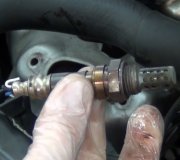What are we talking about here is it Carbondioxide/CO2 or Carbonmonoxide/CO Because the higher the CO2% the better.
Carbon monoxide failures indicate an overly rich fuel mixture. On older carbureted engines without electronic feedback controls, look for things like a stuck choke, misadjusted or fuel saturated float or a rich idle mixture adjustment. On newer vehicles with electronic carburetors or fuel injection, the system may not be going into closed loop because of a bad coolant or oxygen sensor
Here's an Emission Performances Checklist:
There are four things you should always check on every vehicle that has a computerized engine control system:
1. Scan for fault codes. Any codes that are found need to be dealt with before anything else.
2. Make sure the system is going into closed loop. No change in loop status often indicates a coolant sensor problem.
3. Confirm that the system is alternating the fuel mixture between rich and lean. This is absolutely essential for the converter to function efficiently. You can do this by observing the O2 sensors output with a scan tool, or directly with a digital storage oscilloscope or voltmeter. If everything is okay, the sensor should be producing an oscillating voltage that flip-flops from near minimum (0.1 to 0.2v) to near maximum (0.8 to 0.9v). O2 sensors in feedback carburetor applications have the slowest flip-flop rate (about once per second at 2500 rpm), those in throttle body injection systems are somewhat faster (2 to 3 times per second at 2500 rpm), while multiport injected applications are the fastest (5 to 7 times per second at 2500 rpm).
4. Confirm that the system responds normally to changes in the air/fuel mixture. To test the system response, pull off a vacuum hose to create an air leak (not too large or the engine will die). You should see an immediate voltage drop in the O2 sensor output, and a corresponding increase in injector dwell or mixture control dwell from the computer. Making the fuel mixture artificially rich by injecting some propane into the intake manifold should cause the O2 sensor output to rise and the computer to lean out the fuel mixture.
Thursday, April 12th, 2007 AT 8:32 AM



